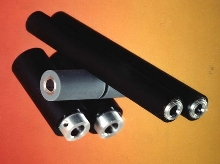Silicone Material eliminates static buildup.
Press Release Summary:
 Semi-conductive Silicone C material is suitable for use on drive and label rollers, and can also be used in direct thermal printing applications. Resistivity is rated down to E9-E12 ohm-cm, and durometers range from 30 to 60 Shore A. Material can withstand 300 to 400° F temperatures, which develop at printhead.
Semi-conductive Silicone C material is suitable for use on drive and label rollers, and can also be used in direct thermal printing applications. Resistivity is rated down to E9-E12 ohm-cm, and durometers range from 30 to 60 Shore A. Material can withstand 300 to 400° F temperatures, which develop at printhead.Original Press Release:
Mearthane Develops Semi-Conductive Cast Silicone
Initial Product Solved ESD Problem in Thermal Print Roller Application
Cranston, RI - Mearthane Products Corporation has announced the development of a proprietary process for making cast silicone semi-conductive. The company, which formulates and fabricates silicone and urethane products for a range of business machine and packaging applications, indicated that initial products made with the Silicone C material include a drive roller for a direct thermal printing application and linerless label roller, that achieved volume resistivity ratings down to E9 ohm-cm and successfully eliminated a static buildup problem which caused periodic shutdowns of the machine.
According to Mearthane's Chief Scientist, Albert C. Chiang, Ph.D., the cast silicone material is processed with a proprietary conductive additive and can be formulated with resistivity ratings as low as E9 to E12 ohm-cm, and in durometers from 30 to 60 Shore A. "Mearthane is the first company to achieve this level of conductivity in cast silicone without adversely affecting physical properties," said Chiang. "Our line of semi-conductive silicones will provide benefits in a wide range of printing, business machine, and packaging applications where ESD is an issue or where anti-static properties are desired."
In an initial application, Mearthane's semi-conductive Silicone C was used to replace non-conductive silicone in transport rollers for a series of direct thermal label printers. Silicone rollers are routinely used for this application because of the material's high release characteristics and its ability to withstand the 300°-400°F temperatures which develop at the printhead. According to Chiang, the machines in question were capable of printing up to 5000 labels per day, but had to be
routinely shut down to allow dissipation of static buildup at the printhead and paper jump. Other schemes to solve the static problem were tried, said Chiang, but the Mearthane Silicone C rollers proved to be the most effective.
"Mearthane has over thirty years of experience with cast silicone," said Chiang, "and is still developing its Silicone C process technology." The company is working with a number of manufacturers on additional applications, including rollers for barcode printers, point of sale printers and medical devices. "We are even working on an offset printing roller and a conductive silicone foam," Chiang reported.




